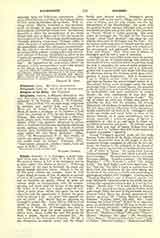

Allegri, ANTONIO, b. in Correggio, a small Lombard town near Mantua, 1494; d. March 5, 1534. His name in history is that of his birthplace, but he is often called “The Master of Parma”. Following the custom of the time he latinized his name and signed himself Antonius Laetus. Details in the life of this great master are meagre. Even in 1542 Vasari found no traces of him, no sketch or portrait of him in all Lombardy. Correggio left no writings, had no teachers, no pupils, visited no great art centers, made no acquaintance with his contemporaries, and never sued the favor of the mighty. His father, it is said, was a small, well-to-do merchant, a good, pious citizen who gave his son an education and the opportunity to become the great artist he proved to be. An uncle “who painted but was no artist” (Dr. Meyer) had no influence on Correggio’s artistic life. From 1518 to 1530 he lived chiefly in Parma. In 1519 he married Girolama Francesca di Braghetis, of Correggio, who died in 1529, The next year the artist returned to his native town, where, during the next five years, he lived a simple, devout and contented life. He was buried in the Franciscan Convent. He left a son, Pomponio, an obscure artist; and the Allegri family soon became extinct. Correggio’s genius unfolded itself in his native village; his few patrons were at Parma, and his only society was the lay Brotherhood of the Benedictines. He ranks with the greatest Italian masters, although some authorities incline to place him at the head of the Decadent or “Sweet” School of Italian painting. The early works of Correggio are “in style of the Ferrarese School” (Jean Paul Richter); and later he was slightly influenced by Mantegna and Da Vinci. But his mature style is peculiar to himself and the principles of his art prevailed in painting and sculpture in the seventeenth and eighteenth centuries over all Italy and France. Then there was a School of Correggio, and he had a host of imitators.
Correggio is the most skillful artist since the ancient Greeks in the art of foreshortening; and, indeed, he was master of every technical device in painting, being the first to introduce the rules of aerial perspective. Radiant light floods his pictures and is so delicately graded that it passes subtly into shade with that play of reflections among the shadows which gives transparency in every modulation. This is chiaroscuro. Even in Allegri’s earliest works it was prominent, and later he became the acknowledged master of it. His refined feeling made Correggio paint the nude as though from a vision of ideal beauty; the sensuous in life he made pure and beautiful; earthly pleasures he spiritualized, and gave expression to mental beauty, the very culmination of true Art. His angel pictures are a cry of “Sursum Corda!” The age in which he lived and worked was partly responsible for this; but his modesty, his retiring disposition, his fondness for solitude, his ideal home-life, his piety, and the fellowship of the Benedictine monks contributed far more to it. Correggio’s early works are simple and naive; later, in some of his church frescoes, he is more conventional; but he always possessed a wondrous grasp of figures in perspective di sotto in su, and gave to them unparalleled movement and grace. He painted angels whose smile was that of happy human love and pictured men in “sublime bliss and in the extremity of great joyousness” (Richter).
Among Correggio’s greatest works are the noble frescoes in the church of St. Paolo, which rank with the best decorations done in the height of the Renaissance, though consigned to oblivion for two centuries; the frescoes in the cathedral; in the church of St. John; and in the convent of the Benedictine nuns,—all of them in Parma. On seeing these frescoes Titian exclaimed: “Were I not Titian I should wish to be Correggio.” His easel pictures are in every great European gallery. Dresden possesses “The Reading Magdalen”, “The Nativity”, called “Die heilige Nacht” (the Holy Night), and three Madonnas. In the “Nativity” the light is made to radiate from the Holy Child and illuminate all the other figures and the whole of the picture, a wholly new proceeding in painting and original with Correggio. Concerning the “Reading Magdalen”, one of the most popular and most frequently copied pictures in the world, the prevailing idea among the critics is that it is not by Correggio. Morelli says: “It is most likely a Flemish work. It is painted on copper, and no Italian artist used copper before the close of the sixteenth century. Director Julius Meyer has already pronounced this picture spurious” [cf. “Italian Masters in German Galleries” (London, 1833), 129-136]. The “Virgin Adoring the Infant Christ” (Uffizi) is an exquisite poem of motherhood, full of all that is tender and sweet in human sentiment. Other celebrated masterpieces are “The Marriage of Saint Catherine” (Louvre); “Madonna in Glory“, (Munich); “Danae” (Rome); “Madonna `del Latte'” (St. Petersburg); “Ecce Homo”, “Madonna della Cesta”, and “Vierge au Panier” (National Gallery); “Madonna and Holy Infant”, called “Il Giorno” (Parma); “Noli me tangere” (Madrid); “Christ in the Garden of Gethsemane” (Apsley House, London); and the “Madonna del Coniglio” or “The Zingarella” (Naples).
LEIGH HUNT

